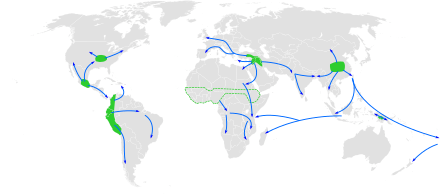Neolithic Expansion

At the beginning of the Holocene, about 12,000 years ago, humanity entered a period of increasing technological sophistication, resulting in the Neolithic Revolution.
Breadmaking considerably predates this period, but people in the Middle East now began cultivating wild cereal and pulses. Dogs had been domesticated over thousands of years; nomadic shepherding became possible through domestication of goats, sheep, horses, camels and cattle.[2]
About 7,000 years ago, livestock herding was sufficiently established to allow a widespread abandonment of hunter-gathering in favour of settled lifestyles. Pottery was increasingly useful, and permanent buildings, constructed from mudbrick,[3][4] appeared. These technologies spread out of the Middle East through the Old World. The Neolithic spread throughout Europe between about 8200 and 6000 years ago.
See also
References
- ↑ Diamond, J.; Bellwood, P. (2003). "Farmers and Their Languages: The First Expansions". Science. 300 (5619): 597–603. Bibcode:2003Sci...300..597D. doi:10.1126/science.1078208. PMID 12714734.
- ↑ Ammerman, A. J.; Cavalli-Sforza, L. L. (1971). "Measuring the Rate of Spread of Early Farming in Europe". Man. 6 (4): 674–88. doi:10.2307/2799190. JSTOR 2799190.
- ↑ Fu, Qiaomei; Rudan, Pavao; Pääbo, Svante; Krause, Johannes. "Complete Mitochondrial Genomes Reveal Neolithic Expansion into Europe". PLoS ONE. 7 (3). doi:10.1371/journal.pone.0032473. PMC 3302788. PMID 22427842.
- ↑ Wood, Tat (2015). World history. Quercus.